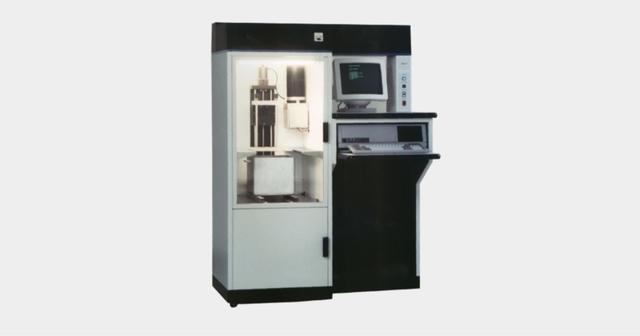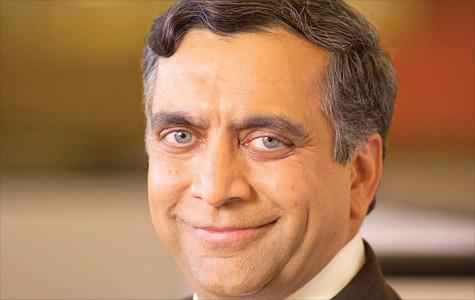As what many would consider the inventor of 3D printing, 3D Systems probably has the most storied history in our industry. It began in 1986, when founder Chuck Hull was awarded his U.S. Patent 4,575,330 titled “Apparatus for Production of Three-Dimensional Objects by Stereolithography”.
Hull was inspired to create the process while using UV light to harden tabletop coatings for a small company. When he proposed his concept for SLA, he was given a small lab with which to pursue its development, curing photopolymers with UV light for months until he finally got it to work. Though three employees of French General Electric Company and CILAS had filed their own patent for stereolithography three weeks ahead of Hull, the companies eventually withdrew their patent application and Hull’s was granted.
Stereolithography converts a 3D model to a physical object by directing a laser onto a vat of photopolymer, curing the material point by point, layer by layer until the print is complete. The process, along with other 3D printing technologies on the horizon, would revolutionize the design and manufacture of goods for years to come. Whereas prototyping was once a labor-intensive and manual process, SLA made it feasible to accurately produce a physical model of a CAD file (with Albert Consulting Group developing the printable STL file format for 3D Systems in 1987).
Despite its potential, as we can now see in 2019, the technology was hindered by cost, complexity, and quality. In 1996, the development of solid-state lasers allowed the company to develop new resins that improved SLA, but large machines still cost in the range of hundreds of thousands of dollars.
In 2001, 3D Systems made the crucial acquisition of a competitor, DTM, expanding its technology portfolio to include selective laser sintering (SLS). This would be the first in a long string of acquisitions that would both enable the skyrocketing growth of the business and eventually weigh it down to the point of near self-destruction.
In 2003, Hull was made to move from chief executive to chief technology officer, while a former vice president to a bubble wrap manufacturer took the reins. The new CEO, Avi Reichental, understood that a key component to further adoption of the company’s technology was reducing the cost and complexity of its machines. He also had to address the company’s large debt and low revenue. Additionally, a lawsuit with SLS manufacturer EOS was underway.
By 2007, the company had stabilized financially and, in 2010, Reichental initiated a period of massive growth characterized by the numerous acquisitions for which the company would come to be known. Between 2010 and 2014, 3D Systems purchased 45 different companies. In 2011, its busiest acquisition year, the firm moved from the NASDAQ to the NYSE and acquired 13 companies.
The businesses bought expanded 3D Systems’ technology, services and material portfolios beyond any other firm in the industry.
Z Corp brought on full-color binder jetting. Phenix Systems added metal powder bed fusion. Geomagic introduced software, while Quickparts and other service bureaus gave 3D Systems a significant 3D printing service. The acquisition of Bits from Bytes added a consumer segment with the Cube line of desktop 3D printers. The purchase of medical VR and 3D printing companies gave the company a foothold in the burgeoning medical space.
In some ways, these acquisitions represented a rough sketch of Reichental’s vision for the future of the technology. He imagined every home owning at least one if not more 3D printers and not just for plastic goods, but also food and full-color objects.
At the same time, the vision and hype could not match the reality. As the consumer 3D printing bubble burst in 2014, investors launched a class-action lawsuit against the company for publishing misleading statements suggesting that 3D Systems could manufacture metal 3D printers and drive demand for its consumer 3D printers more quickly than the company was able. Moreover, the suit claimed that inflated stock prices allowed Reichental and another executive profit off of the sale of their own stocks.
The crash for 3D Systems, therefore, came quickly. From 2014 to 2015, the company began shutting down facilities, including those dedicated to binder jet technology and consumer 3D printing. By the end of the year, Reichental stepped down and the company’s consumer segment was ended.
It was a dramatic time for the original inventor of SLA and one of the most prominent companies in the 3D printing industry, but all was not lost, and, in April 2016, a new CEO took over with a goal of setting 3D Systems back on the right path. Vyomesh Joshi had previously served as a vice president at HP, where he was responsible for doubling the profits of its printing business.
3D Systems stock hasn’t hit the over-inflated numbers it once saw during the peak of the 3D printing bubble, but Joshi has completely refocused the company. It would difficult to say from the outside if he has stabilized it financially, but things seem to be a lot less marketing-driven as they were under the previous CEO.
The company continues to release new products and materials, focusing on building up its Healthcare division as a model it can extrapolate onto other verticals, such as aerospace. At the same time, it means to develop its modular continuous 3D printing system, the Figure 4. Time will tell where it heads from here, but the story is far from over yet.
Join the discussion of this and other 3D printing topics at 3DPrintBoard.com.
Subscribe to Our Email Newsletter
Stay up-to-date on all the latest news from the 3D printing industry and receive information and offers from third party vendors.
You May Also Like
3D Printing News Briefs, April 27, 2024: Research, Digital Dentistry, Cycling, & More
We’re starting today’s 3D Printing News Briefs with some research into 3D printed luminescent quantum-dot polymer architectures and free-form laser beam shaping, and then on to an open source 4-axis...
HP & INDO-MIM Collaborate to Boost Metal 3D Printing in India
HP Inc. and INDO-MIM, a US- and India-based supplier of metal injection molding (MIM) powders and contract manufacturer, have announced that the two companies will collaborate to accelerate additive manufacturing...
3D Printing News Briefs, February 17, 2024: Shot Blasting, Service Bureaus, & More
In today’s 3D Printing News Briefs, we’re starting out with post-processing, as SKZ Würzburg is using a shot blast system from AM Solutions for its research. Moving on to business,...
3D Printing News Unpeeled: Not That Kind of Organ 3D Printing
GKN Aerospace will create a 150 jobs in Trollhattan Sweden with an investment of $60 million part of which comes from the Swedish Energy Agency’s Industriklivet initiative. The investment will...




































